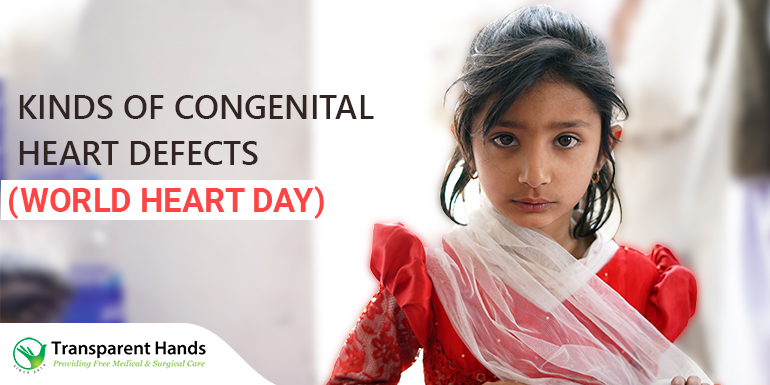Kinds of Congenital Heart Defects (World Heart Day)

A congenital heart defect refers to an anomaly in the heart that is present in the patient by birth. With modern surgical techniques and the latest technology, most of these cardiac defects can not only be diagnosed now but treated and surgically corrected as well. Some of the most common heart defects and their causative factors are listed below:
1. Septal Defects
Septum refers to the wall that is present between the chambers of the heart. There are two kinds of septal defects known as Atrial Septal Defects and Ventricular Septal Defects.
- Atrial Septal Defects
Atria are the collecting chambers of the heart. In these kinds of defects, a hole is present in the wall between the atria. Therefore, a larger amount of blood flows into the right atrium due to which it gets enlarged. To close the hole, either a catheter or a surgical procedure is required.
- Ventricular Septal Defects
According to the CDC, ventricular septal defect (VSD) is estimated to be the most common type of heart defect. In this condition, there is a hole between the two chambers that are responsible for pumping blood to the body. These chambers are known as the ventricles. As a result, there is the mixing of blood that is rich in oxygen with blood that is poor in oxygen content (1). Non-surgical treatment options, for this defect, include the use of catheters. Whereas, corrective surgeries can also be performed for its repair.
2. Tetralogy of Fallot
Tetralogy of Fallot is a defect that impacts the blood flow in the heart. It comprises four different heart anomalies. A baby with this defect may require urgent surgery, which is why it is classified as a critical congenital cardiac defect. The defect may be caused due to inherited genes or other environmental factors such as the mother’s diet and medications taken by her during the pregnancy. The only effective treatment method for TOF is surgical correction (2).
3. Patent Ductus Arteriosus
Ductus arteriosus is present in all babies as it is an essential fetal structure. However, it closes soon after birth, normally. The chances of incidence of this defect increase in premature babies. It is also found to be more prevalent in children born with specific genetic syndromes. PDA can either be cured with medicines or a catheter can be used in case of a non-surgical treatment option. Surgery can also be performed for its repair. The selection of the most suitable treatment option varies from case to case (3).
4. Aortic Valve Stenosis
Aortic valve stenosis is a highly prevalent cardiac valve defect. In this condition, the aortic valve narrows down. Because of this, the blood from the left ventricle to the aorta gets restricted. Symptoms include shortness of breath, chest pain, and lightheadedness. Treatment options comprise medications, valve replacement, or valve repair (4).
5. Transposition of the Great Arteries
In this cardiac anomaly, the two major arteries that carry blood from the heart are switched. The defect may be diagnosed during the course of pregnancy or after the birth of the baby (5). For its treatment, an atrial switch procedure is required. The two kinds of atrial switch procedures that are conducted include the Mustard procedure and the Senning procedure (6).
How to Keep Our Hearts Healthy- In a Nutshell
With the ever-increasing popularity of fast food and packaged snacks, it is more important now than ever before, to take care of our hearts. Regular physical activity and a healthy diet are most helpful in this regard. Smoking and alcohol consumption should be avoided or at least kept to a minimum. Cholesterol levels need to be regularly monitored and managed.
Cardiac Surgeries Sponsored by Transparent Hands
Our organization is dedicated to providing quality healthcare services to the underprivileged community in Pakistan. Among other kinds of surgeries that are conducted under the umbrella of our organization, a large number of patients also get treated for cardiac issues. Some of the diagnostic and treatment procedures being conducted include angiography, stenting, valve replacement surgeries, and open heart surgery. We have collaborated with Pakistan Children’s Heart Foundation in this regard. The patients are managed and treated through a joint effort of both organizations.
World Heart Day
World Heart Day is observed on 29th September every year. Efforts are made by activists and healthcare professionals to raise awareness regarding the significance of heart health. Seminars and talks are conducted to educate people concerning the preventive measures that they can take to keep their hearts in the best possible shape and protect themselves from chronic diseases. Furthermore, people who have a genetic predisposition to cardiac illnesses or are already suffering from an issue are also guided through different awareness campaigns.
References
- National Health Service. Congenital Heart Disease [Internet]. [cited 2021 Jun 9]. Available from: https://www.nhs.uk/conditions/congenital-heart-disease/types/
- Centers for Disease Control and Prevention. Congenital Heart Defects – Facts about Tetralogy of Fallot [Internet]. [cited 2021 Jun 9]. Available from: https://www.cdc.gov/ncbddd/heartdefects/tetralogyoffallot.html
- Schneider DJ, Moore JW. Patent ductus arteriosus. Circulation [Internet]. 2006 Oct 24 [cited 2021 Jun 9];114(17):1873–82. Available from: http://www.circulationaha.org
- American Heart Association. Aortic Stenosis Overview [Internet]. [cited 2021 Jun 9]. Available from: https://www.heart.org/en/health-topics/heart-valve-problems-and-disease/heart-valve-problems-and-causes/problem-aortic-valve-stenosis
- CDC. Congenital Heart Defects – dextro-Transposition of the Great Arteries (d-TGA) [Internet]. [cited 2021 Jun 9]. Available from: https://www.cdc.gov/ncbddd/heartdefects/d-tga.html
- Warnes CA. Transposition of the great arteries. Circulation [Internet]. 2006 Dec 12 [cited 2021 Jun 9];114(24):2699–709. Available from: http://www.circulationaha.org










Leave a Reply